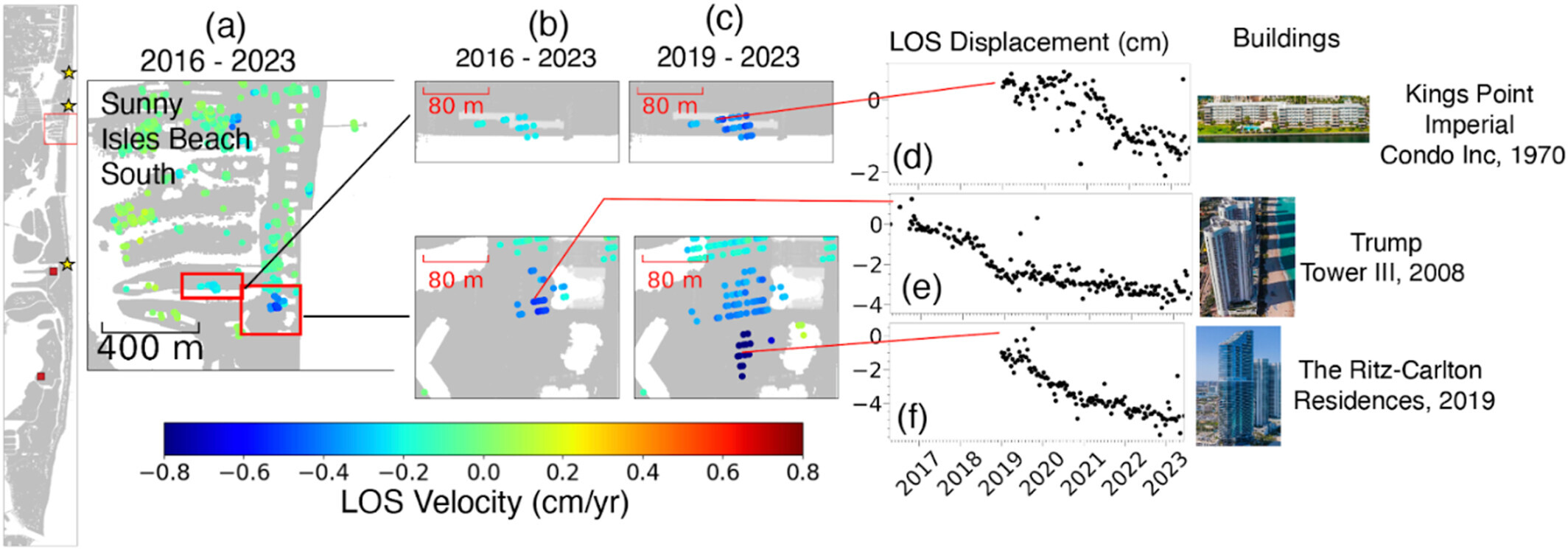Nearly three dozen buildings from Miami Beach to Sunny Isles Beach are sinking at “unexpected” rates, a new University of Miami study found.
Those familiar with luxury real estate in Miami know many of the buildings by name: Four Seasons Residences at the Surf Club, Porsche Design Tower, Estates at Acqualina and two Trump towers.
It’s not a cause for alarm, said senior author Falk Amelung, a professor of geophysics in the Department of Marine Geosciences at the University of Miami Rosenstiel School of Marine, Atmospheric, and Earth Science.
“People don’t have to be concerned. These buildings were subsiding for quite a while,” he told The Real Deal. “They’re not going to collapse. They were very well built.”
The study, authored by researchers at UM as well as other collaborators, examined buildings from 2016 to 2023. Subsidence, or sinking, ranging from two to eight centimeters (less than an inch to about three inches) was found, with the most significant effects in Sunny Isles Beach. Other buildings affected are in Miami Beach, Surfside and Bal Harbour. The study relied on satellite images over the seven-year period that used reference points such as building balconies, air conditioning units and boardwalks to measure the buildings’ shifts.
Amelung said differential settlement can cause damage, but researchers found little evidence of differential settlement, which is defined as uneven sinking or settling of a structure’s foundation.
High-rises will typically settle during and immediately after construction. The study found that it persists for many years.
Farzaneh Aziz Zanjani, the study’s lead author, said in a press release that ongoing monitoring and a deeper understanding of the long-term implications of settlement are needed. Buildings along the coast in Broward and Palm Beach counties are also likely experiencing subsidence (or sinking), according to the report. “The discovery of the extent of subsidence hotspots along the South Florida coastline was unexpected,” Aziz Zanjani said in her statement.
Taller and newer towers are typically much heavier than those built decades ago. Contractors dig piles that are in some cases well over 100 feet deep for the foundations of these structures.



Florida Atlantic University Professor Khaled Sobhan, a co-author of the study, said in the release that other factors may be contributing to these buildings sinking, such as “groundwater flow from pumping for underground construction.”
The region’s geologic makeup could be contributing to the subsidence in South Florida. That makeup includes quartz sands from the Appalachians that formed layers of sand within the limestone, according to the report. The shifting of these grains in the sandy layers, triggered by the weight of the buildings and the vibrations during construction, is likely causing much of the sinking.
“Ongoing subsidence may also be influenced by daily tidal flows and the cracking of limestone beneath the surface,” according to the release.
The report also found that the collapse of Champlain Towers South in Surfside in 2021 was not caused by the building settling. No displacement signals were found prior to the tragedy occurring. The Miami Herald first reported on the study.
“The absence of settlement is surprising,” the release states, “especially considering the strong vibrations from the construction of the nearby Eighty Seven Park Tower, which has subsided by several centimeters since its completion.”
